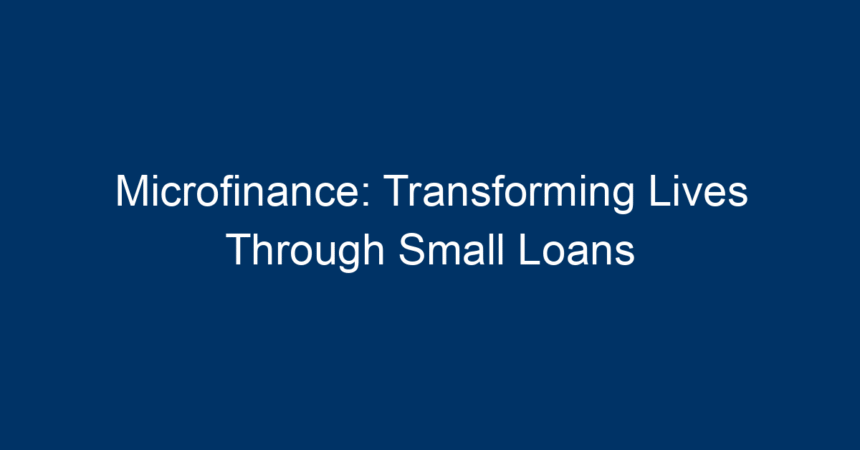Microfinance has emerged as a powerful tool for poverty alleviation and economic empowerment. By providing small loans to individuals who lack access to traditional banking services, microfinance institutions (MFIs) are transforming lives and communities around the world. This article delves into the principles, benefits, challenges, and future of microfinance, shedding light on how small loans can lead to significant changes for individuals and entire economies.
What is Microfinance?
Microfinance refers to a range of financial services aimed at low-income individuals or those who do not have access to conventional banking. These services include microloans, micro-savings, micro-insurance, and remittances. The primary goal of microfinance is to support entrepreneurship and allow individuals to improve their livelihoods, thereby promoting self-sustainability.
The Roots of Microfinance
The microfinance movement began in the 1970s, primarily through the efforts of Dr. Muhammad Yunus in Bangladesh. He provided small loans to impoverished women, enabling them to start small businesses. His work not only won him the Nobel Peace Prize in 2006 but also laid the foundation for the global microfinance industry.
How Microfinance Works
Microfinance institutions typically follow a unique lending model that is different from traditional banks. Here’s a closer look at how it works:
1. Group Lending
Many MFIs use a group lending model, where small groups of borrowers come together to guarantee each other’s loans. This builds trust and reduces the risk of default, as group members are motivated to support one another.
2. Flexible Loan Terms
Microfinance loans are often designed with flexible repayment terms that cater to the borrower’s cash flow. This allows borrowers to repay the loan based on their income cycles, which is especially important for those involved in seasonal work.
3. Affordable Interest Rates
While interest rates on microloans are generally higher than traditional loans due to the higher risk involved, they are still affordable for the target demographic. MFIs are often committed to providing loans with fair interest rates that don’t exploit borrowers.
Benefits of Microfinance
Microfinance has far-reaching benefits that extend beyond just financial assistance. Here are some key advantages:
1. Empowerment of Women
Microfinance has been particularly effective in empowering women. By providing women with financial independence, microfinance allows them to contribute to their families and communities economically. Studies show that when women control financial resources, they invest significantly in their children’s education and health.
2. Job Creation
Small businesses funded through microfinance have the potential to create jobs within communities. As these businesses grow, they often need to hire additional staff, reducing unemployment and fostering local economic development.
3. Improved Quality of Life
Access to microloans enables individuals to invest in better housing, health care, and education. The resulting improvements in living conditions contribute to overall community development, promoting a cycle of prosperity.
4. Financial Inclusion
Microfinance bridges the gap between marginalized communities and the larger financial system. By connecting these individuals to financial resources, microfinance promotes financial literacy and helps them build credit histories, making it easier for them to access larger loans in the future.
Challenges Facing Microfinance
Despite its many benefits, the microfinance sector faces several challenges:
1. Over-Indebtedness
One major concern is the risk of over-indebtedness among borrowers. If clients take multiple loans from various MFIs without a proper repayment plan, they may find themselves in a vicious cycle of debt.
2. High Interest Rates
While microfinance loans generally offer affordable interest rates, some MFIs charge excessively high rates that can lead to borrower exploitation. Transparency in lending practices is essential to protecting vulnerable populations.
3. Limited Financial Education
Lack of financial literacy remains a significant barrier. Many borrowers are unaware of the implications of taking loans or how to manage their finances effectively, which can lead to poor financial decisions.
The Future of Microfinance
The microfinance landscape is continuously evolving. Emerging trends suggest a promising future for microfinance:
1. Digital Microfinance
The rise of technology is transforming the microfinance sector. Digital platforms are making it easier for borrowers to access loans, manage their repayments, and even receive financial education. Mobile banking and fintech solutions are paving the way for a more inclusive financial ecosystem.
2. Integration with Sustainable Development Goals
As global awareness about poverty and inequality increases, the microfinance sector is aligning itself with the United Nations Sustainable Development Goals (SDGs). By focusing on initiatives that promote gender equality, decent work, and economic growth, the future of microfinance holds the potential to create a more equitable world.
3. Impact Measurement
There is a growing emphasis on measuring the social and economic impact of microfinance initiatives. By collecting data and conducting impact assessments, MFIs can evaluate their effectiveness and ensure they are meeting the needs of their clients.
Conclusion: Harnessing the Power of Microfinance
Microfinance represents a vital resource for millions of individuals worldwide, providing them with the financial tools necessary to uplift themselves from poverty. As we continue to evolve in a rapidly changing world, it’s crucial for stakeholders—including government bodies, NGOs, and the private sector—to collaborate in creating a robust microfinance ecosystem.
Actionable Insights
-
Educate Yourself and Others: Understanding the principles and practices of microfinance can empower you to make informed decisions or even become an advocate for change in your community.
-
Support Ethical MFIs: Whether you are looking to invest or simply seeking to support microfinance, choose institutions that prioritize fair practices and transparency.
-
Promote Financial Literacy: Encourage financial education initiatives within your community to help empower future borrowers and prevent the pitfalls of over-indebtedness.
- Engage with Technology: Stay updated on the advancements in digital microfinance, as technology plays a pivotal role in making financial services accessible to underserved populations.
By harnessing the transformative power of microfinance, we can continue to build a world where everyone has the opportunity to thrive.




